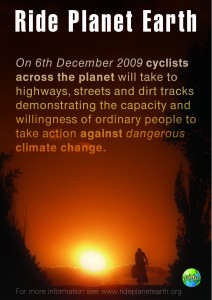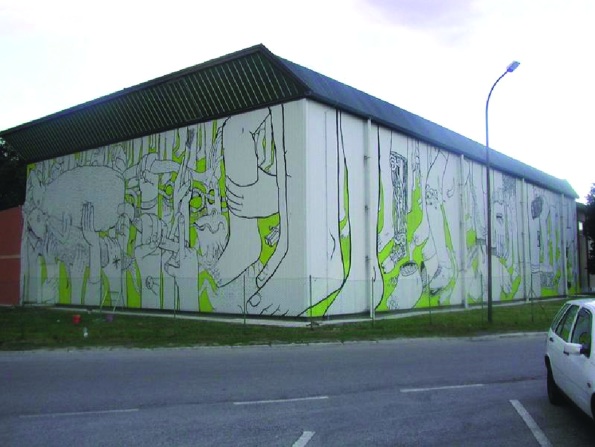Archive
Join the Ride! Start Cycle Change: Stop Climate Change
Ride Planet Earth: On 6th December 2009 cyclists across the planet will take to highways, streets and dirt tracks demonstrating the capacity and willingness of ordinary people to take action against dangerous climate change.
The next day, in Copenhagen Denmark, the most important climate change negotiations in more than a decade will begin. Our actions will be urging the government delegations of developed countries to:
…act on climate change now, to fulfil their international obligations, taking responsibility for their historic and current greenhouse emissions by reducing emissions immediately and making domestic emission reduction targets of at least 40% by 2020.
To assist countries in the developing world to adapt to climate change impacts, reduce their greenhouse emissions and finance low-carbon technology, enabling them to develop in an ecologically and socially sustainable way.
Ride Planet Earth is promoting behaviour change, focusing on environmentally sustainable transport and travel, as part of the action necessary to fight dangerous climate change. Carbon fuel based transport and travel accounts for roughly 35% of industrialised nations’ carbon emissions. Therefore addressing this issue is key to ensuring a safe and stable climate.
Ride Planet Earth is also raising awareness about the impact of climate change on communities in the non-industrialised world. We believe increased awareness leads to behaviour change, as people realise the potential impact their actions can have on vulnerable communities on the other side of the planet.
To find out more about this great project/action against dangerous climate change, just visit the website here.
Tradition is thrown out the window
When we think of a library, we normally portray images of silence, study, students, removed from the rest of the world. Fortunately for UTS and its surrounding areas, OJMM have put forward a proposal that breaks down the traditional idea of a library and opens it up to create a public space which helps blend the university into life in the city.
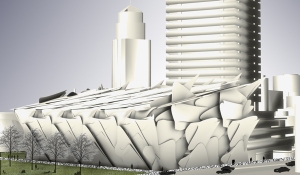 When can a private university become a place where the library building is a hotbed of public interaction? OJMM have designed a drop in, drop off retrieval system for the new UTS library which makes it very similar to a video store. An active retail zone, cinema, open study areas and places of worship, mean that this library is hardly the place to disappear but a place to get involved. There are traditional study rooms but these are not limited to students, food courts and exhibition spaces showcasing the university and public works. The interactive and weather responsive facade makes this building much more appropriate and aware of its users needs.
When can a private university become a place where the library building is a hotbed of public interaction? OJMM have designed a drop in, drop off retrieval system for the new UTS library which makes it very similar to a video store. An active retail zone, cinema, open study areas and places of worship, mean that this library is hardly the place to disappear but a place to get involved. There are traditional study rooms but these are not limited to students, food courts and exhibition spaces showcasing the university and public works. The interactive and weather responsive facade makes this building much more appropriate and aware of its users needs.
OJMM architecture
Art and Architecture
With materiality being such an integral part of Architecture, we tend to see a combination of art and architecture with a greater focus on the possibilities for each other, how one can help the other advance. Materiality can have an effect on the quality of space; it can affect how the user reacts or interprets/uses the space. Throughout the architecture world, we see design constantly evolving/developing into a new style, but one thing all these different styles have in common is they all have a meaning, a reason for being, whether it is the minimalist ‘purity’ of modernism or the ‘neo-eclecticism’ of Post-modern architecture or the idealistic manifestoes of Paper architecture. What all these styles also share in common is the idea that art plays a major role especially in the materiality and how it blurs the line between art and architecture.
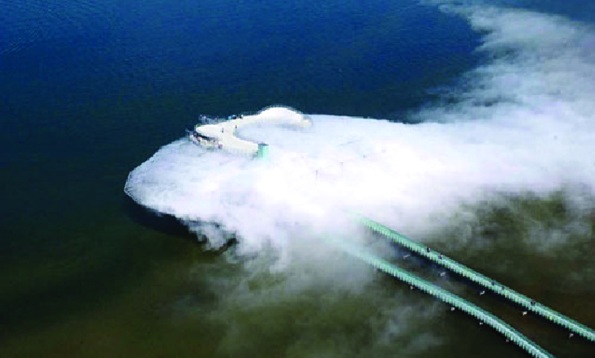 When for instance we look at Diller & Scofidio’s Blur Building, we are challenged to define what it is, architecture or art installation? As the name suggests, the lines are blurred for the user/observer, even materiality is questioned as the architects put forward the idea that a cloud, or mist can be seen as materiality, converging over the building. In Yves Klein’s Air Architecture, he goes on to suggest that “With the three classical elements, fire, air and water, the city of tomorrow will be built, flexible at last, spiritual and immaterial”. He goes on to say “The idea in space, of using pure energy as a material with which to construct, no longer seems absurd in this way of thinking”. Can materiality in architecture be as flexible as he suggests? What is the purpose of materiality and in what ways will this affect the architect and the architecture they produce? How does conceptual art play a role in conceptual architecture?
When for instance we look at Diller & Scofidio’s Blur Building, we are challenged to define what it is, architecture or art installation? As the name suggests, the lines are blurred for the user/observer, even materiality is questioned as the architects put forward the idea that a cloud, or mist can be seen as materiality, converging over the building. In Yves Klein’s Air Architecture, he goes on to suggest that “With the three classical elements, fire, air and water, the city of tomorrow will be built, flexible at last, spiritual and immaterial”. He goes on to say “The idea in space, of using pure energy as a material with which to construct, no longer seems absurd in this way of thinking”. Can materiality in architecture be as flexible as he suggests? What is the purpose of materiality and in what ways will this affect the architect and the architecture they produce? How does conceptual art play a role in conceptual architecture?
For Dan Graham, conceptual art “wanted to reject materiality. Conceptual art was context-dependant, it linked itself and drew meanings from other things that were material”, and for self defined conceptual architects, Diller & Scofidio, they try and show through projects such as the blur building, that conceptual architecture can also try to reject traditional material. With Blur building, there is a perception that what we see and what we are walking into is not so much a building but an idea, an idea which can be argued loses its essential meaning once things like building services, fire exits, etc come into play, so the argument is there that ideas like that of Diller & Scofidio as constructed objects need to disappear and only remain on paper for them to be entirely successful.
One of the biggest issues in architecture during the last 100 years is how the image has been a technique, an integral tool of architecture where as now, it has become material. An image possesses materiality, whether it be physical or conceptual, that is used during the process in the making of a piece of art or architecture. Take Herzog and De Meuron, their buildings appear generic, but their can be an interest in how something generic can become affecting. With the application of images to their buildings, they become representations from outside of the architecture.
In an interview with Jacques Herzog, when talking about the leaf pattern that was applied to the Ricola-Europe Warehouse in Mullhouse, France, he states that it was a struggle to find the image, photographed by Karl Blossfeldt, and to try and determine its module.
Ricola-Europe, Mullhouse, France
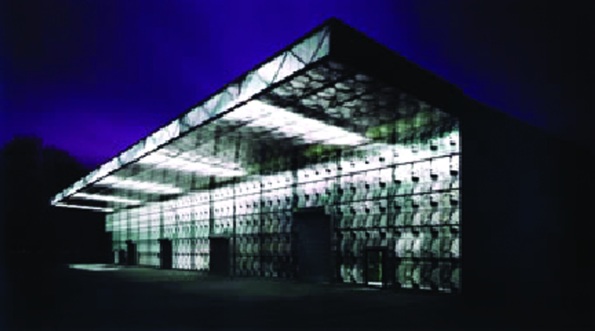 When we go through the process of trying to identify an image, we can see that it tries to contain a spatial depth, but because it is an image, it does not possess one. With the Ricola warehouse, the image of the leaf creates a type of interference with the flat surface of the building, and its visibility depends on the direction of the light hitting it. This allows for the image, in this case being the leaf, to complex the simple form in a way that causes confusion. It gives the building a sense of form, because of the warehouse’s simplicity, which in turn works in harmony with the image of the leaf which gives the building a sense of materiality. It can be argued that because the image is placed on the building as a piece of art, it makes the building into architecture, because the image becomes a material that creates an architectural effect that allows the building to have architectural qualities.
When we go through the process of trying to identify an image, we can see that it tries to contain a spatial depth, but because it is an image, it does not possess one. With the Ricola warehouse, the image of the leaf creates a type of interference with the flat surface of the building, and its visibility depends on the direction of the light hitting it. This allows for the image, in this case being the leaf, to complex the simple form in a way that causes confusion. It gives the building a sense of form, because of the warehouse’s simplicity, which in turn works in harmony with the image of the leaf which gives the building a sense of materiality. It can be argued that because the image is placed on the building as a piece of art, it makes the building into architecture, because the image becomes a material that creates an architectural effect that allows the building to have architectural qualities.
An internal view of the Ricola-Europe Warehouse
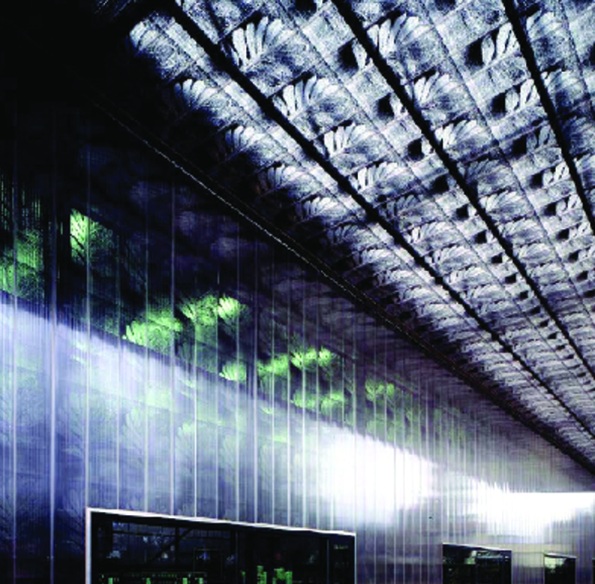 Another project Herzog and De Meuron have produced is the Eberswalde Technical School Library, 1999, Germany. The building is entirely covered with images generated by a photographer named Thomas Ruff who got his images from newspapers and high art. Similar to the Ricola-Europe warehouse, it gives the building a sense of materiality which again allows for the art to become apart of the architecture.
Another project Herzog and De Meuron have produced is the Eberswalde Technical School Library, 1999, Germany. The building is entirely covered with images generated by a photographer named Thomas Ruff who got his images from newspapers and high art. Similar to the Ricola-Europe warehouse, it gives the building a sense of materiality which again allows for the art to become apart of the architecture.
Although this is a recent trend in the architectural world, Herzog and De Meuron were not the first to try and incorporate art as materiality; we can see similar ideals with Rem Koolhaas’ ZKM Centre for Art and Media Technology in Karlsruhe, Germany. However what Koolhaas did was to sample images from advertising which represented its natural environment.
Throughout architectural history however, especially during the Roman Baroque period, there has been attempts at coordinating architecture with paintings to create a spatial effect. Artists like Andrea Pozzo would paint ceilings with an aim of giving a certain illusion to the viewer below, they would be looking at a painting and not a curved surface which was meant to be hidden behind the painting. Images have provided a space within the architectural technique it was used for but now, the image has developed into material.
Another trend that is occurring in Architecture is the use of painters and graffiti artists to create materiality through the use of imagery on the buildings. Also, there are a few artists who are now changing the way we look at street art especially as a legitimate way of incorporating art with architecture. One of these artists is an Italian man named Blu. Blu’s street art differs from the typical graffiti we normally see all over the city walls, in fact, drawing on a wall is not about notoriety for him, it’s about changing the landscape or the way the building is viewed.
Blu sees architecture as a form of art, he describes buildings as, “sheets of paper, needing to be given life, some sort of purpose”, and this way of thinking can be seen with Herzog and De Meuron’s work. He cites Gordon Matta-Clark’s work as an influence in the way he uses architecture, “The way Matta-Clark used the building as a sculpture, and it’s something I try to imitate when I paint”.
By using buildings as a canvas, Blu manages to not only give a building an artwork, but his work has the ability to give it a sense of spatial depth and materiality. In the end, the work does not become what appeals to him, he is more interested in people’s reactions and how his work can change the perspective of a building, “Painting in public spaces is a really interesting social experiment. What I like most is not the piece itself, but people’s reaction, and how the piece is being digested by the city. At the beginning, it is something new: It can be pleasant or disturbing, depending on the point of view. Then, with time, it becomes part of everyday life, and it can take on an old, familiar flavour, like those old, rusted billboards or advertising murals, forgotten in the corners of our cities”.
Above we see a factory which previously had white rendered walls but has now been turned into a canvas of artwork. Blu has given the building a sense of depth, colour, and materiality that works into its surroundings. The artwork depicts dozens of legs and hands chained together working in a sort of factory line telling a story of what conditions could be like inside this building. A passer by will look at this building and try to understand why it is there, what it is used for and what does the architecture mean. Like Gordon Matta-Clark, he has created a site specific artwork which in turn allows for the art to integrate into the architecture and create a site specific piece of architecture.
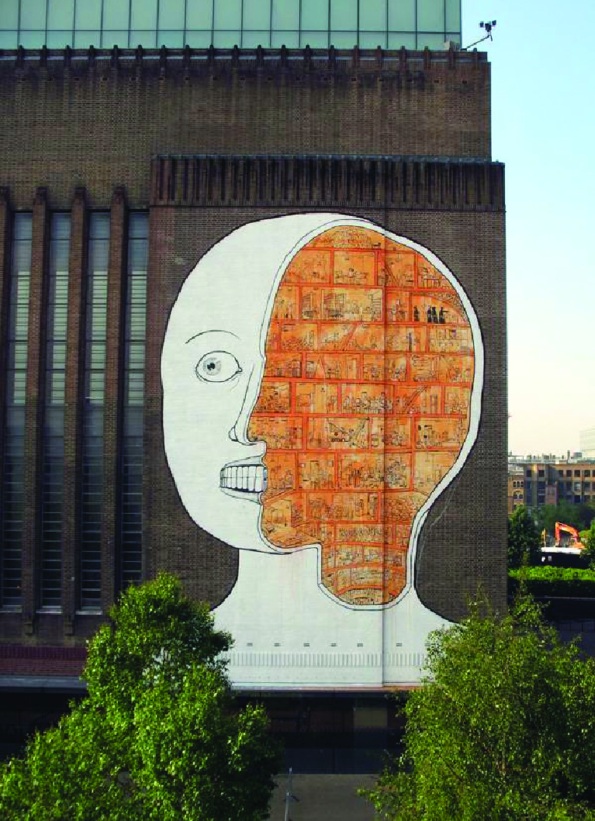 A recent street art exhibition in the Tate Modern, London, showcased work by Blu and one of the more interesting pieces was one he painted on the actual walls of the Tate Modern. The painting depicts half a human head with the inside revealed as if it is a section of a building containing many different floors and rooms. In every room, Blue has depicted a different scenario of things that are happening in the world today, things that are relevant. He touches on subjects such as the terrorism, prisoner torture, energy consumption etc. These issues depicted on the side of a building through artwork change the whole perspective one looks at the Tate Modern Museum. A museum is usually a place where the building, the architecture houses the art internally, the artwork is displayed. However, through Blu’s work, the building itself has now become the artwork, he has used the architecture as inspiration for his images, and in turn the images have transformed the building into a canvas.
A recent street art exhibition in the Tate Modern, London, showcased work by Blu and one of the more interesting pieces was one he painted on the actual walls of the Tate Modern. The painting depicts half a human head with the inside revealed as if it is a section of a building containing many different floors and rooms. In every room, Blue has depicted a different scenario of things that are happening in the world today, things that are relevant. He touches on subjects such as the terrorism, prisoner torture, energy consumption etc. These issues depicted on the side of a building through artwork change the whole perspective one looks at the Tate Modern Museum. A museum is usually a place where the building, the architecture houses the art internally, the artwork is displayed. However, through Blu’s work, the building itself has now become the artwork, he has used the architecture as inspiration for his images, and in turn the images have transformed the building into a canvas.
Olafur Eliasson’s The Weather Project and Blu’s work can be compared in the sense that they have used the museum as their canvas, one is a painting and the other an art installation, but both interact with the architecture & manipulate the building to use it as a tool for their work.
The Jewish Museum in Berlin by Daniel Libeskind is a project we can look at where its materiality has really become a storyteller, it’s become paramount to the experience. The project was titled “Between the Lines”, which is in reference to its structure as there are 2 linear shapes that evoke a vision of a deconstructed Star of David. The façade of the building is in many ways similar to that of Matta-Clark’s ‘cut’ series which shows lines cut into the zinc plated building, these lines create an image of complexity, which details the relationship between Jews and non Jews in Germany. Libeskind uses imagery and art installations such as Menashe Kadishman’s fallen leaves, to try and develop a relationship between the architecture and the message. He uses art in his architecture as materiality, trying to convey a message by using certain materials.
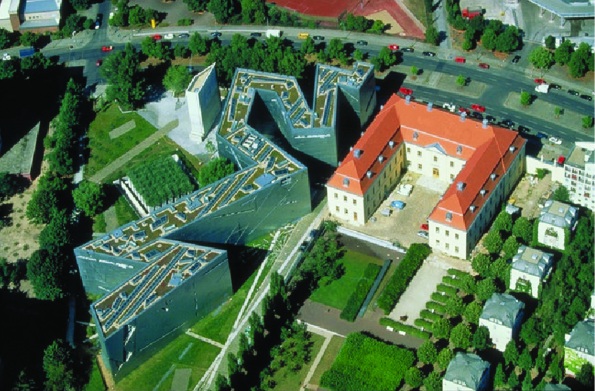 It can be argued that Libeskind’s Jewish Museum is not the architecture containing the artwork, but it is the piece of art itself. The building is an experience, voids, tunnels, cuts, are all symbolising a part of Jewish history in Germany, they become part of the museum, the architecture is the art, and the art is the architecture.
It can be argued that Libeskind’s Jewish Museum is not the architecture containing the artwork, but it is the piece of art itself. The building is an experience, voids, tunnels, cuts, are all symbolising a part of Jewish history in Germany, they become part of the museum, the architecture is the art, and the art is the architecture.
Architecture has a very complex relationship with materiality; overtime architecture has evolved in terms of design and materiality due to the technical advances. Now we are looking at a time where the use of natural elements as building materials is a relevant form of design, we are looking at how artwork is being used on buildings to create or reshape form. Interaction is now playing a big part in architecture and the use of artworks, art installations, etc, are playing a role in how people respond and how art can transform a building and create new architecture.

Blu’s short film – Muto
CARROTMOB STRIKES SYDNEY!
Dont consider yourself the “activist” type? Well now the bar has been lowered!
So how can something so simple as buying a something at the MFC Supermarket, Surry Hills on the 24th of October (Global Day of Climate Action) make you an environmental activist?
This little independent supermarket have pledged to spend 20% of the money you spend there on the Carrotmob day towards “greening” their store. But what does this mean for you? Well the more people come and the more people spend the more MFC will earn and put towards creating a more environmentally sustainable business! Grass roots reverse-boycott!
So bring your friends and buy something (anything – the groceries you would have bought somewhere alse anyhow!) – and you will be taking part in a global revolution!
Carrotmob’s have been going on all the way from Brooklyn to Helsinki and Berlin to San Fransisco where it all started. And now on the 24th of October you can be part of the first Carrotmob in the Southern Hemisphere!
Details are as follows:
|
Saturday, 24 October 2009
|
|
| Time: |
11:00 – 14:00
|
| Location: |
Surry Hills MFC Supermarket
|
| Street: |
435 Crown Street
|
| Town/City: |
Surry Hills, Australia
|
Come down and support a good cause!
Passion or die
One of my favourite artists of all time is the late great Bob Marley. Whatever he did, whether it was perform live on stage, play a game of football or smoke marijuana in true Rasta tradition, he oozed passion, you knew he was doing it for the love of it. One of my favourite videos is of an interview with Bob Marley, below, where he displays his love of football. The man knew how to live, even though a toe infection is reportedly what led to his early death, he seemed like he had fulfilled what he set out to do. That passion is what is necessary especially in Architecture, because it definitely isn’t the money that will keep you going!
When Bob Marley was buried, so was his Gibson Les Paul guitar, marijuana, a bible, a ring and a football.
Archi-ballin’
In a football team, traditionally the most important and valuable player has been the role usually held by the player wearing the Number 10. Pele, Maradona, Platini, Baggio, Zidane are probably names most people in the world would know and associate with the position of number 10 and it is no coincidence that these greats were also known as the architects.
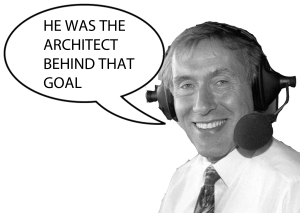
Football Commentator:Martin Tyler
The architects being the creators, the thinkers, the dictators, they would at times with what seemed like a simple run, a basic pass, a point of the finger bamboozle the opposition. Parallels can be drawn between the number 10 and an Architect as creators of space, this space can then be defined and interpreted by the players involved. A few years ago, Dan Hill wrote an interesting piece on this very topic on the City Of Sound. Hill looks at how “This emphasis on unpredictable, interpreted creativity being performed within formal systems actually suggests interesting parallels to me, reminiscent of those discussed in my recent ‘Architecture and interaction design’ summary. I talked of ‘the social process of design’; of the interaction between a system of space, articulated by designers or architects, which is then interpreted and adapted by users with individual creativity and agency.”
What Hill continues to analyse is the different styles of football that are considered the correct way of playing the game. But football, like architecture is subjective, we like what we like for various reasons, whether its the subtle simplicity of Le Corbusier or the big, bold, titanic buildings of Frank Gehry, the sublime defence splitting passes of Zidane or the mazy mind blowing dribbling of Lionel Messi, there is more than one way!
